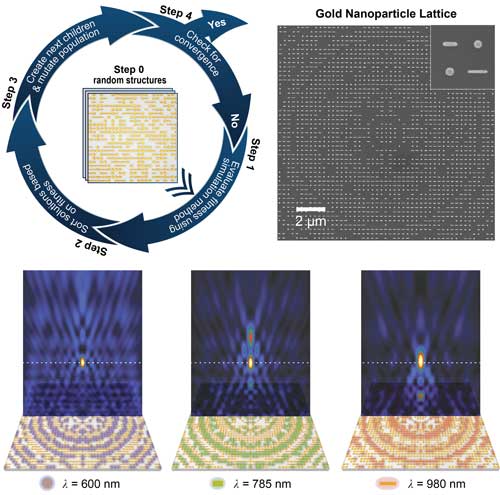| Posted: Oct 28, 2016 | |
Ultra-thin achromatic lenses optimized by an evolutionary algorithm |
|
| (Nanowerk Spotlight) Planar optical components are crucial to realize miniaturized optical systems and integrated optoelectronic devices. In particular, metasurfaces – 2D structured materials with rationally designed, subwavelength-scale building blocks – are of great interest for applications ranging from high resolution imaging to three-dimensional (3D) holography. | |
| Recent work has shown that dielectric meta-lenses with a thickness of 600 nm can image at visible wavelengths with diffraction-limited resolution. However, these lenses suffered from prominent chromatic aberration, where the focus shifted as the wavelength of incident light changed. | |
| Achromatic metasurfaces, which can maintain the same focal distance over a range of wavelengths, have been realized by engineering each subwavelength unit to induce an identical phase change at all wavelengths. | |
| However, the design method requires intensive computation and is limited to 1D focusing, which precludes practical applications. The two major disadvantages of nearly all approaches to metasurface design are lack of versatility and low efficiency. A fast, efficient systematic design method has not yet been realized. | |
| Now, though, researchers have developed a highly efficient, universal algorithmic method based on evolutionary principles for the design of ultra-thin achromatic lenses. | |
| "We have taken an evolutionary approach to designing flat multiwavelength achromatic lenses based on subwavelength plasmonic gold nanoparticles," Teri W. Odom, Charles E. and Emma H. Morrison Professor of Chemistry and Professor of Materials Science and Engineering at Northwestern University, tells Nanowerk. "Our lattice evolution algorithm (LEA) achieved desired optical responses by tuning the arrangement of the phase units on a discrete square lattice." | |
| Odom and her team have published their findings in the October 27, 2016, online edition of ACS Nano ("Plasmonic Lattice Lenses for Multiwavelength Achromatic Focusing"). | |
| "By using gold nanoparticles with different surface plasmon resonances, we could manipulate different wavelengths of incident light independently within a single lattice structure," explains Jingtian Hu, a graduate student in Odom's group and the paper's first author. "Our method could solve for lens structures having high numerical apertures, which enabled focal spots with diffraction-limited dimensions." | |
| By tuning the size and shape of nanoparticles used as building blocks for the lenses, the researchers designed optical components that could operate over a wide range of wavelengths, from the visible to near-infrared. | |
| They also achieved dynamically switching of focusing profiles by changing the incident polarization using the same algorithm and anisotropic particle shapes. | |
 |
|
| Lattice lenses optimized by an evolutionary algorithm demonstrated achromatic focusing at three widely separated wavelengths. The shape of lattice units was tuned to exhibit different surface plasmon resonance to interact selectively with these wavelengths. Because evolutionary algorithms allowed efficient multi-objective optimization, lattice structures could be designed to achieve the same focal spot location at all three wavelengths. (Image: Jingtian Hu, Northwestern University) (click on image to enlarge) | |
| In previous work ("Subwavelength Lattice Optics by Evolutionary Design"), the group reported LEA to be an efficient approach to design flat optics based on subwavelength hole arrays in a gold film. | |
| "In contrast to metasurface design by analytical equations, LEA represents the desired optical property by a fitness function and uses a genetic algorithm to find the structure with the optimized fitness value," notes Odom. | |
| The team's algorithm realized efficient multiobjective optimization and produced achromatic lattice lenses at up to three wavelengths (600 nm, 785 nm, 980 nm) using multiple different nanoparticle shapes. They anticipate, however, that chromatic control can be extended to even shorter lens wavelengths (200-500 nm) by using alternative plasmonic materials and can eventually result in broadband achromatic focusing. | |
| "We expect the evolutionary-algorithm approach of nanostructure design will lead to advances in a variety of fields, from integrated optoelectronics to miniaturized optical interconnects to high-resolution optical microscopy," concludes Odom. | |
| This work might be of particular interest for the computational nanotechnology community interested in developing fast, efficient design methods for functional nanostructures and the nanophotonics community interested in developing compact, aberration-free systems of micro-optics. | |
 By
Michael
Berger
– Michael is author of three books by the Royal Society of Chemistry:
Nano-Society: Pushing the Boundaries of Technology,
Nanotechnology: The Future is Tiny, and
Nanoengineering: The Skills and Tools Making Technology Invisible
Copyright ©
Nanowerk LLC
By
Michael
Berger
– Michael is author of three books by the Royal Society of Chemistry:
Nano-Society: Pushing the Boundaries of Technology,
Nanotechnology: The Future is Tiny, and
Nanoengineering: The Skills and Tools Making Technology Invisible
Copyright ©
Nanowerk LLC
|
|
|
Become a Spotlight guest author! Join our large and growing group of guest contributors. Have you just published a scientific paper or have other exciting developments to share with the nanotechnology community? Here is how to publish on nanowerk.com. |
|
